8 Types of Skylights and How to Choose One for Maximum Sunlight
Brighten your everyday


Skylights can transform a home—adding natural light, beauty, and architecture to any space. They can make your bedroom, living room, or bathroom feel brighter and more spacious. Skylights can also reduce your energy bills and provide ventilation. Before cutting a hole in your ceiling, learn about the different types of skylights and how to choose one for your home.
1. Fixed Skylights
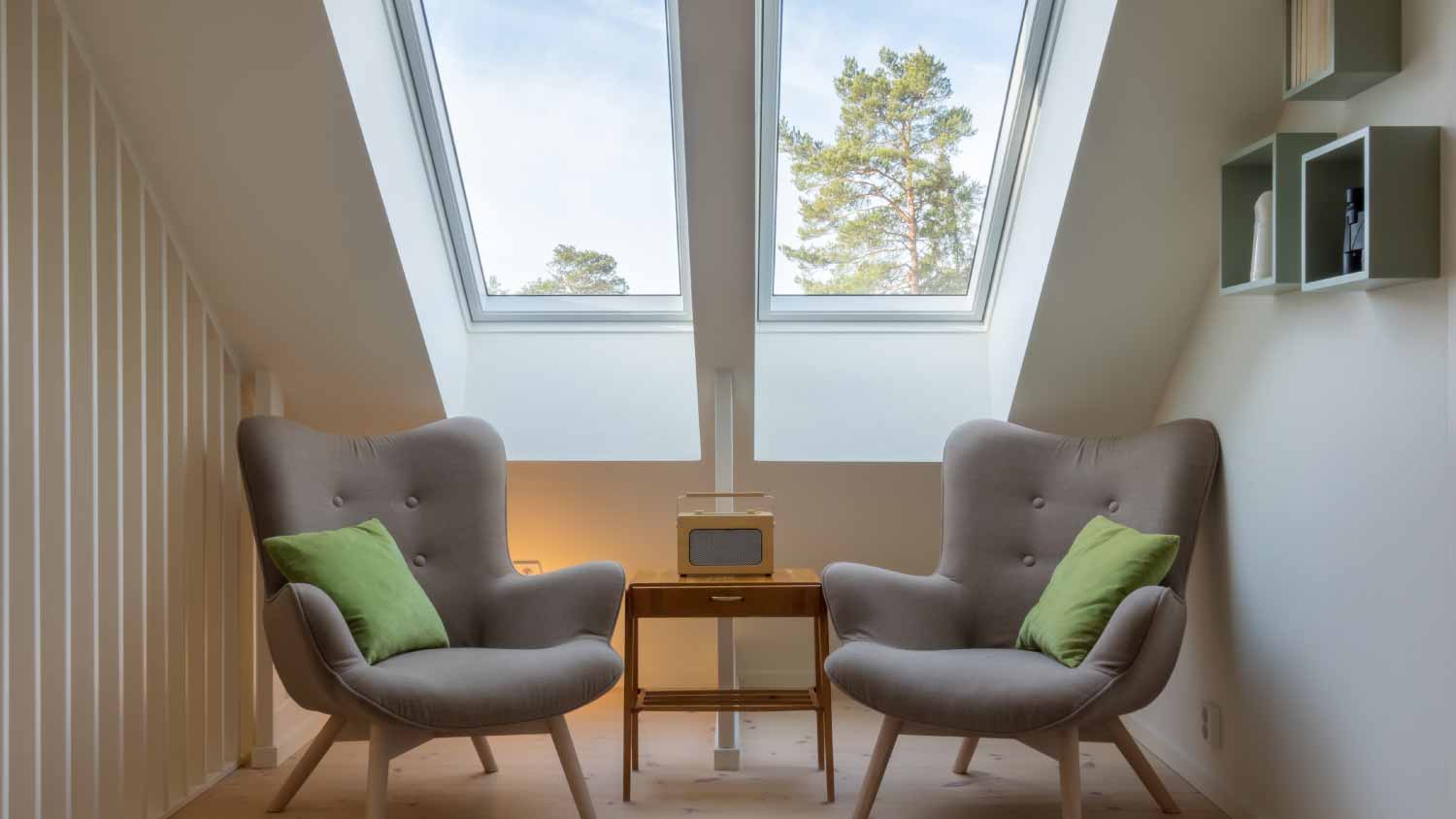
A fixed skylight is a glass or plastic skylight that does not open or close. It can be any shape or size. You might place a fixed skylight on a cathedral ceiling or a high ceiling that you can't reach, as opening and closing the window would be a challenge, anyway. Fixed skylights add natural light and a view of the outdoors. They often have durable plastic domes on the exterior to protect them from water and weather. Because fixed skylights don't offer ventilation, they might not be the best for a bathroom, kitchen, or laundry room.
| Pros | Cons |
|---|---|
| Affordable | No ventilation |
| Provide natural light | Can increase cooling costs |
| Lower risk of leaks |
Best For: High ceilings or rooms where no additional ventilation is necessary
2. Vented Skylights
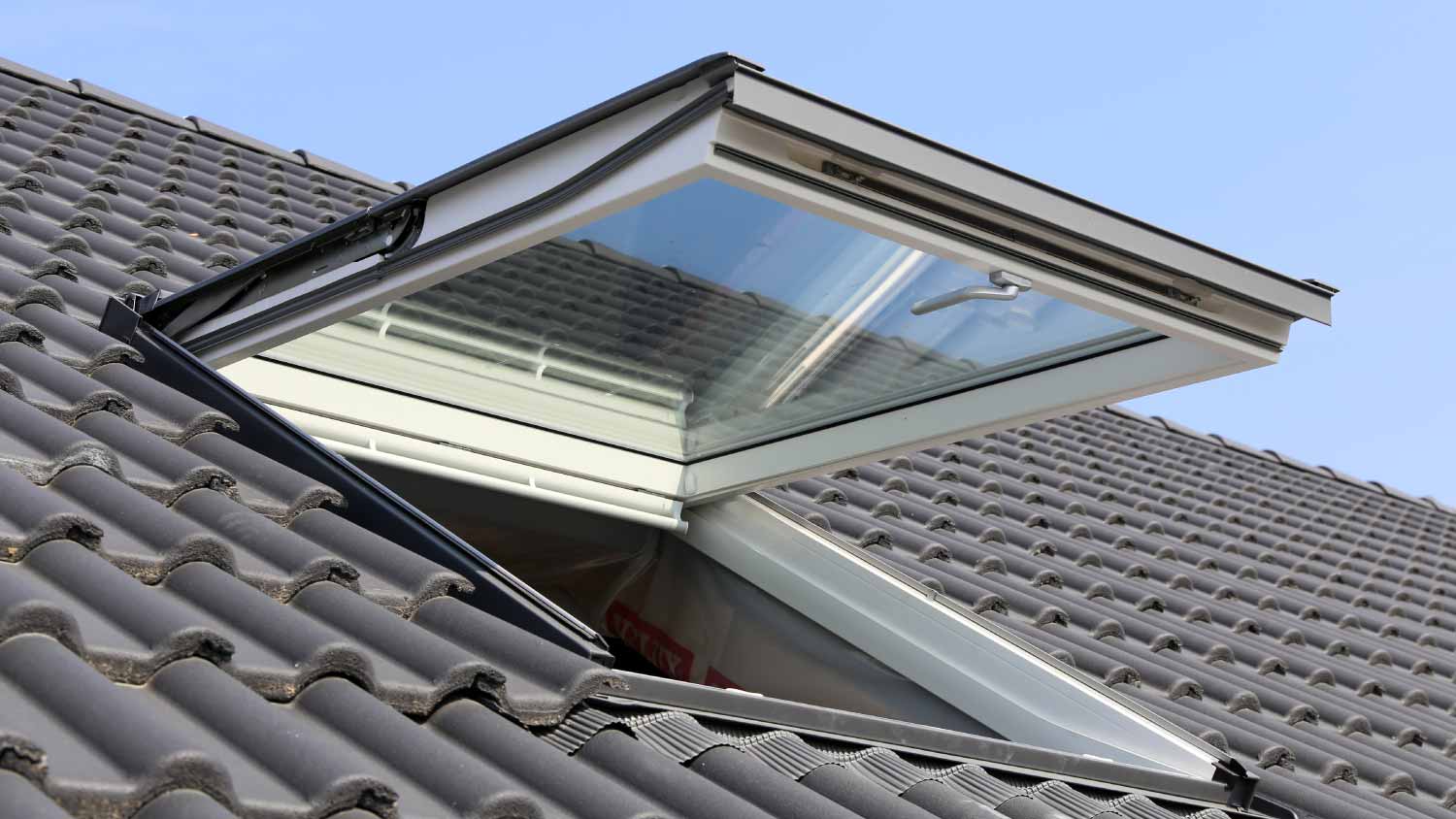
A vented skylight can open and close, offering airflow and ventilation. The operation can be manual, electric, or solar-powered. Vented skylights are great for kitchens and bathrooms because they allow moisture to escape. Some vented skylights are tilt-window skylights that allow for a small opening, while others are center-pivot skylights that open more. Vented skylights can also double as emergency exits if they meet the building code and are accessible without a ladder.
| Pros | Cons |
|---|---|
| Provide ventilation | More expensive than fixed |
| Offer natural light | Risk of leaks |
| Can be a point of egress | Can be challenging to operate |
Best For: Adding ventilation to bathrooms, kitchens, or laundry rooms.
3. Tubular Skylights
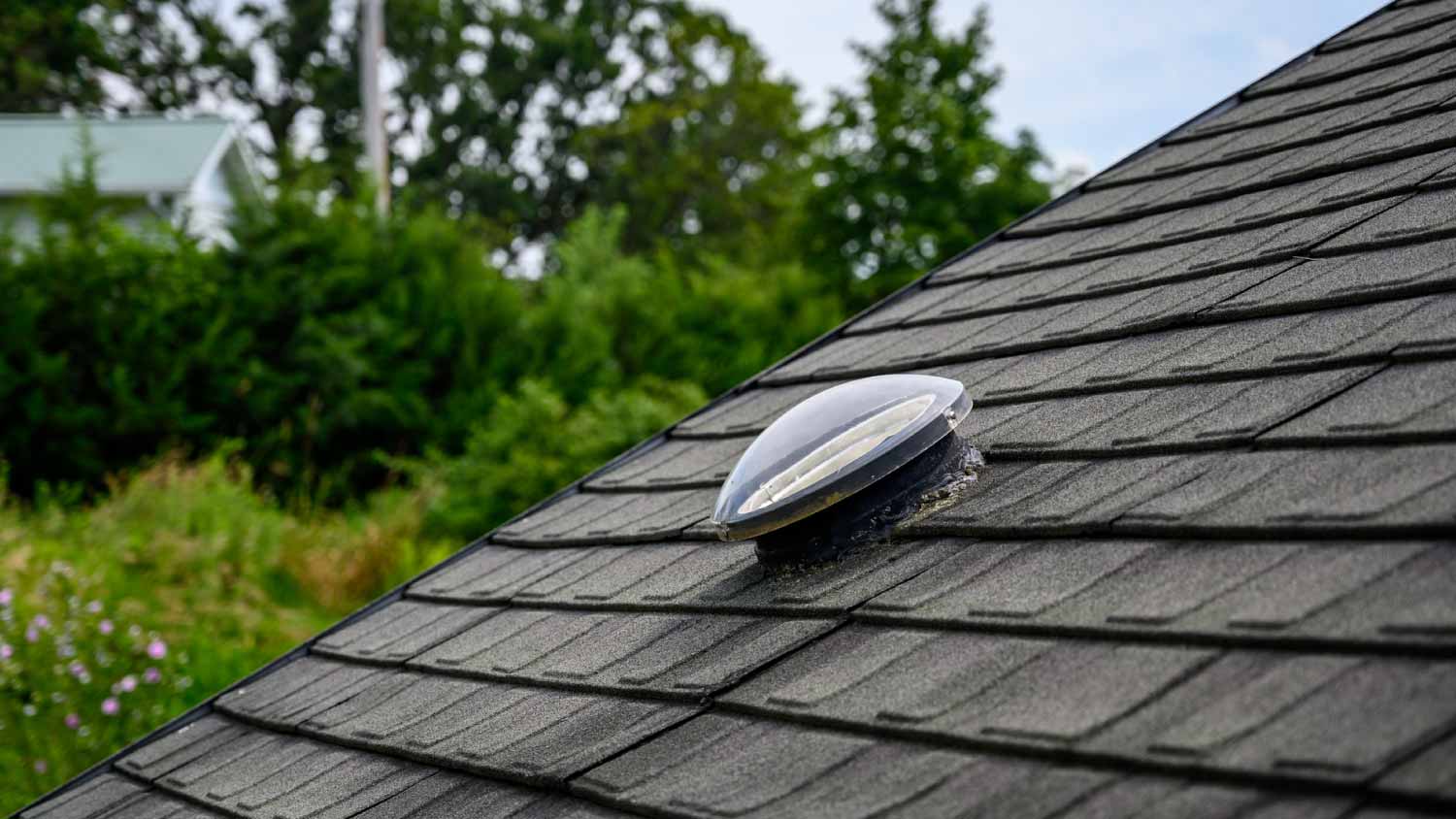
Tubular skylights, also called solar tubes, are cylindrical tubes that carry light from the roof to a room in your home. The tubing is flexible, allowing it to fit between obstructions, such as around wiring or venting. The interior shape can be round or square.
Solar tubes are a practical and functional way of adding natural light to your home but don't provide a view of the sky or outdoors. Tubular skylights are ideal for smaller spaces like hallways, closets, entryways, or bathrooms.
| Pros | Cons |
|---|---|
| Provide natural light | No view of the outdoors |
| Affordable | No ventilation |
| Lower risk of leaking |
Best For: Adding natural light to smaller areas, like hallways and closets.
4. Dome Skylights
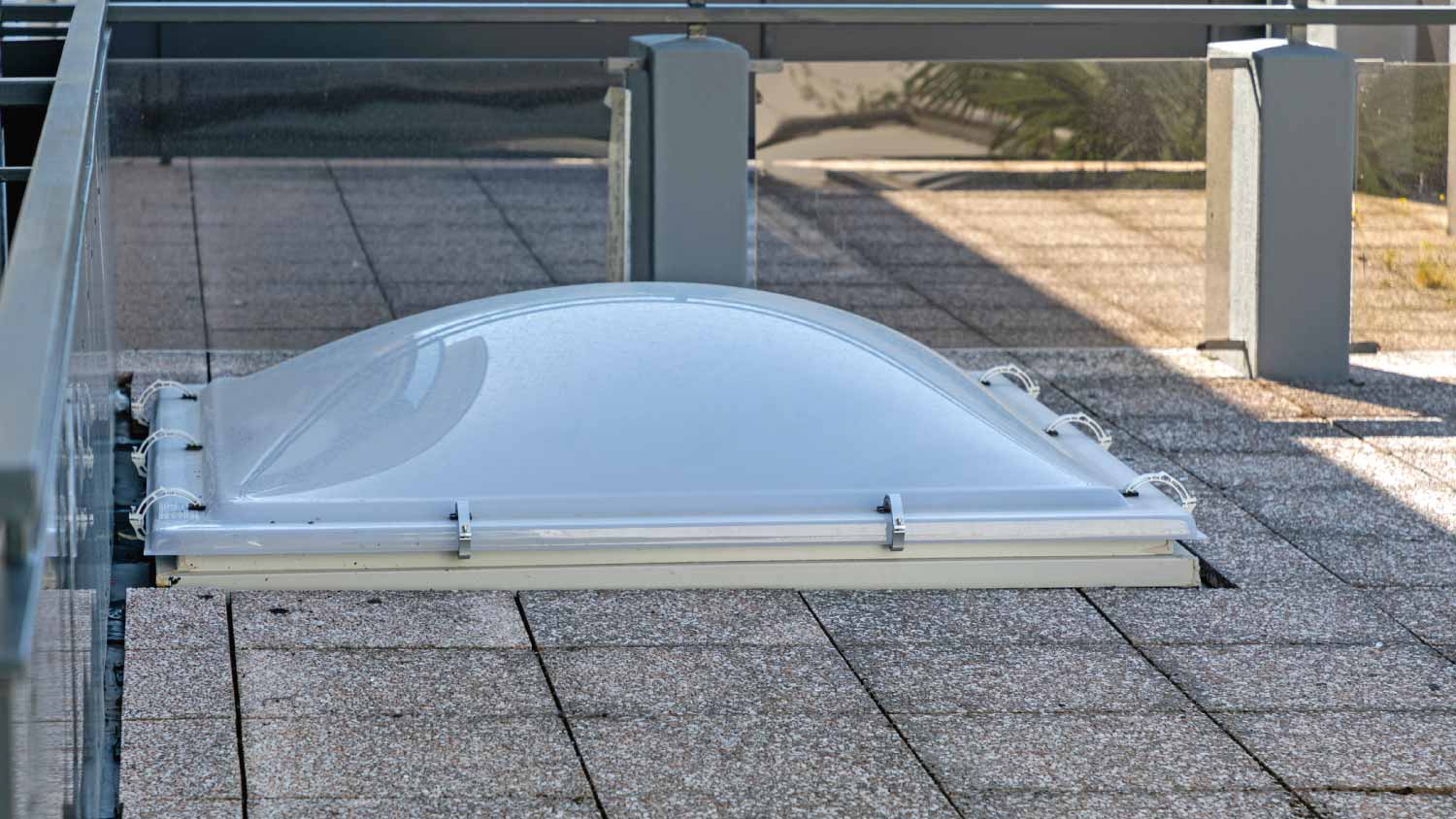
Domed skylights feature a dome, often made of acrylic. They hold up well in harsh weather, shedding water off the sides and staying strong against the elements. The curvature in the plastic also ensures light enters your living no matter which direction the sunlight is coming in from.
| Pros | Cons |
|---|---|
| Low risk of leaking | No ventilation |
| Affordable | Not the most visually appealing |
| Stands up to harsh weather | No view of the outdoors |
Best For: Homes in areas with extreme weather where flat glass skylights could be damaged or broken.
5. Pyramid Skylights
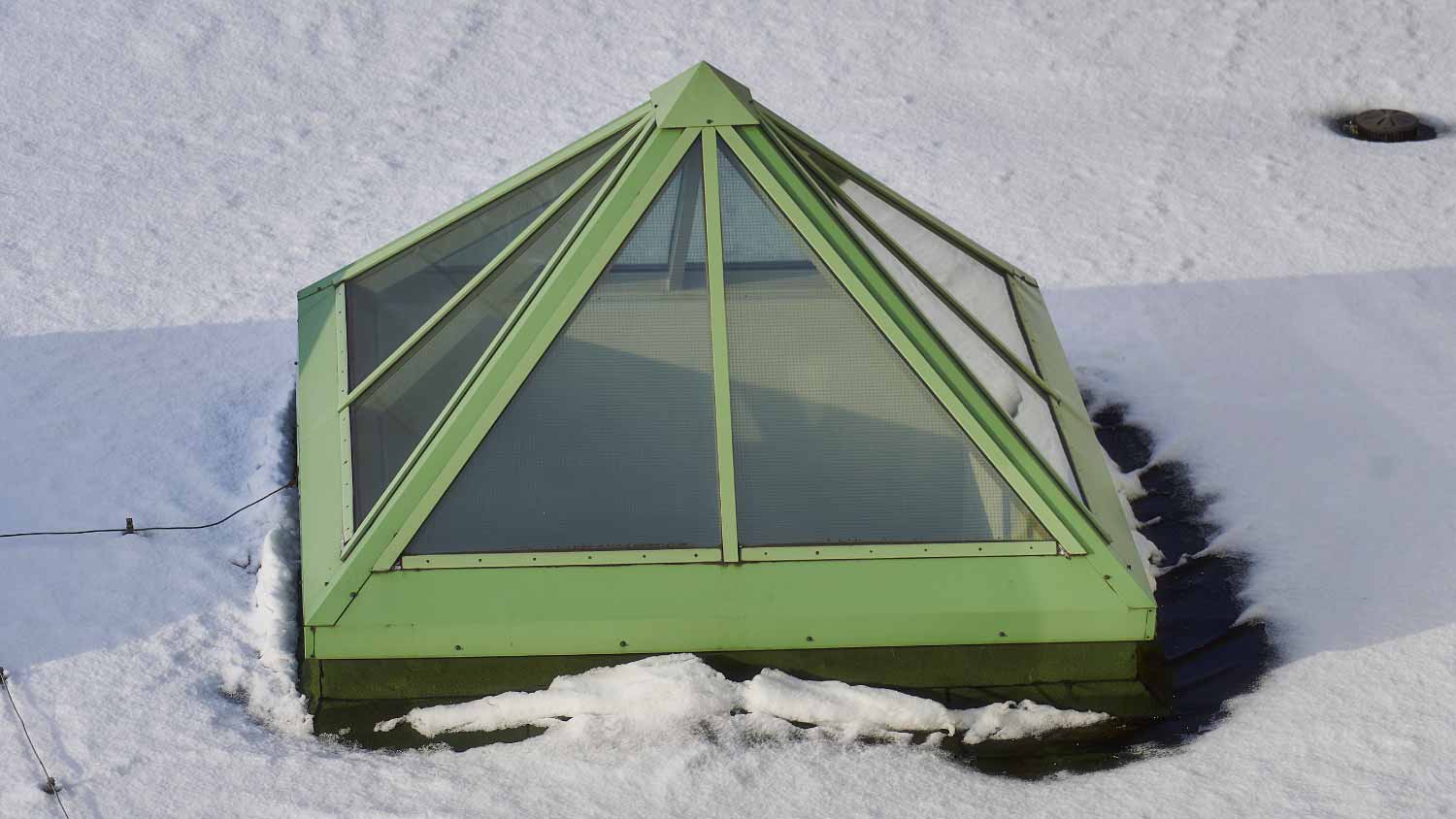
A pyramid skylight is a multi-dimensional structure that resembles the shape of a pyramid. It allows a large stream of natural light into a space, such as a kitchen or dining room. Because of their impressive design, pyramid skylights enhance the interior and exterior aesthetics of a home. Pyramids can be some of the most expensive skylights, but they also reduce energy use due to not needing as many overhead lights.
| Pros | Cons |
|---|---|
| Provides ample natural light | Usually no ventilation |
| Low risk of leaking | Not ideal for all home styles |
| Can improve curb appeal | Expensive |
Best For: Homeowners who want to maximize natural light inside and add some intrigue to their curb appeal.
6. Ridge Skylights
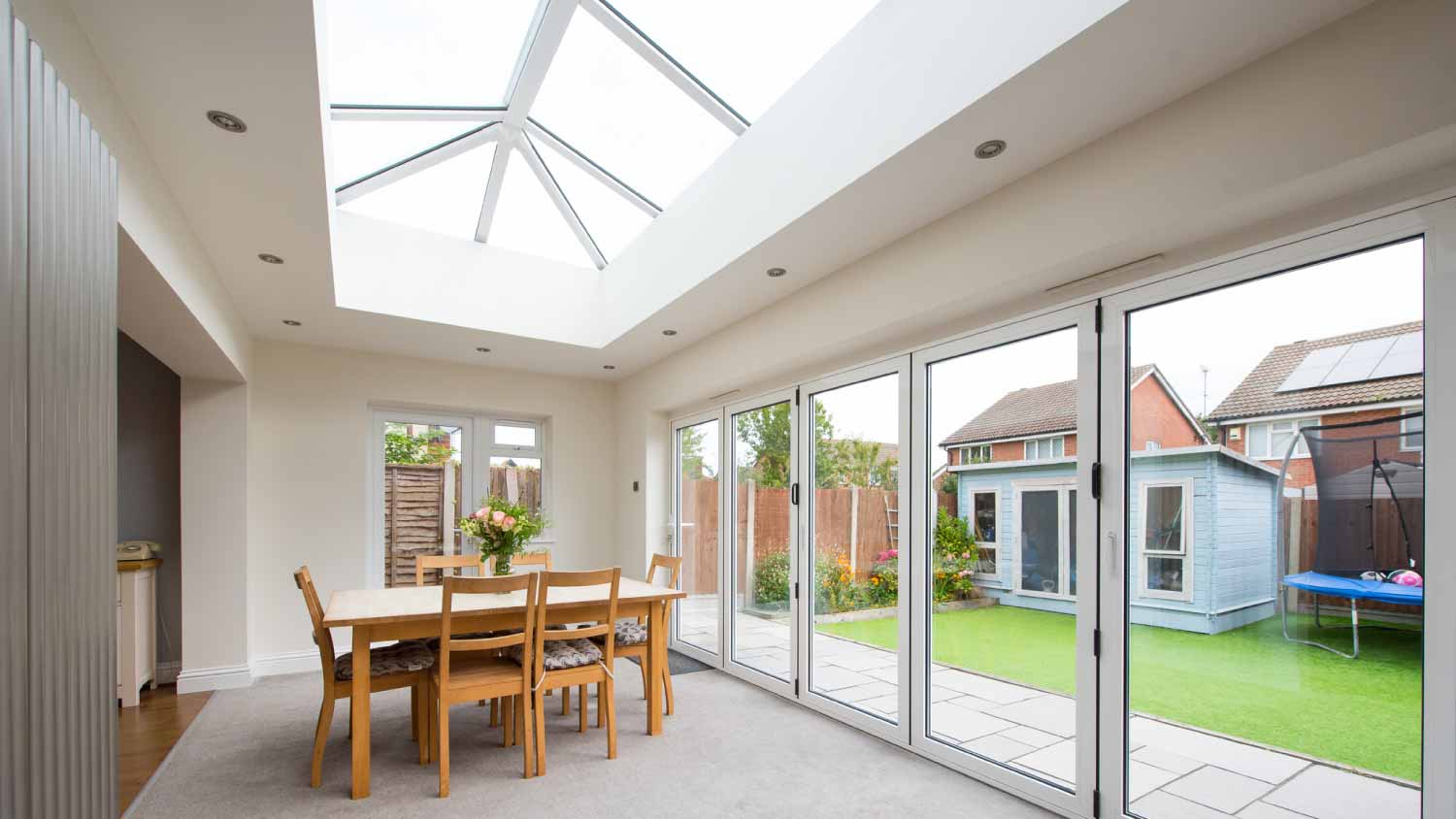
A ridge or gable skylight follows the line of the roof pitch, resulting in a large A-shaped skylight. You can also install a ridge skylight on a flat roof, designing it with a pitch in the middle. Ridge skylights allow tremendous light into the space and add to the interior aesthetics.
| Pros | Cons |
|---|---|
| Large amount of natural light | Expensive |
| Adds intrigue to home | Not suitable for all roofs |
| Often larger than other types | Often lacks ventilation |
Best For: Flat roofs or roofs with low pitch, especially over dining tables or other entertainment areas.
7. Double or Triple Skylights
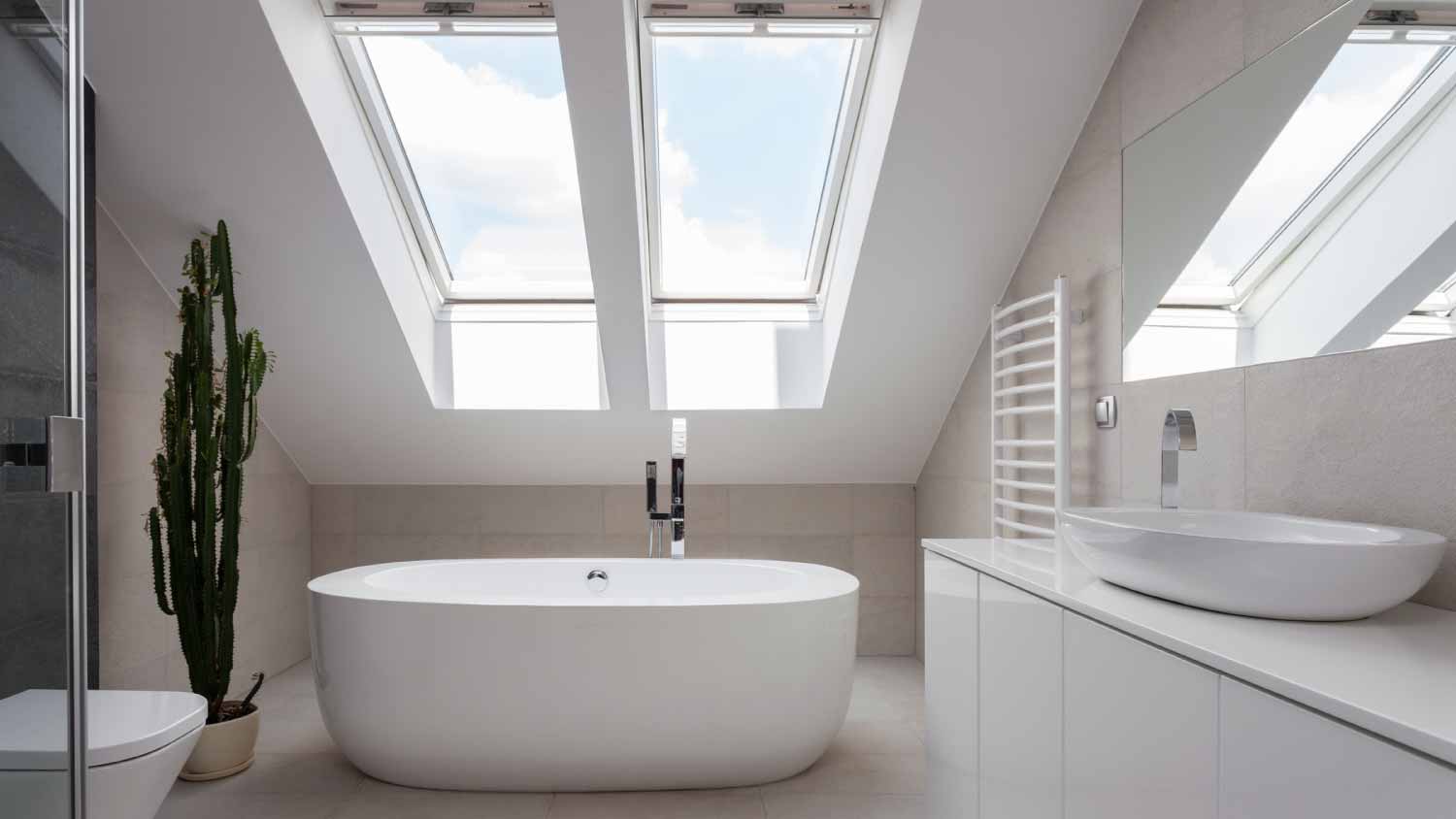
You can place two or three (or more) skylights next to each other to create larger light streams entering your home. The use of multiple skylights forms a stunning aesthetic that’s great for a kitchen, dining room, bedroom, or living room.
| Pros | Cons |
|---|---|
| Increases natural light | Very expensive |
| Can provide ventilation | Not always possible to install |
Best For: Introducing maximum natural light into an area and making the interior and exterior more aesthetically pleasing.
8. Custom Skylights
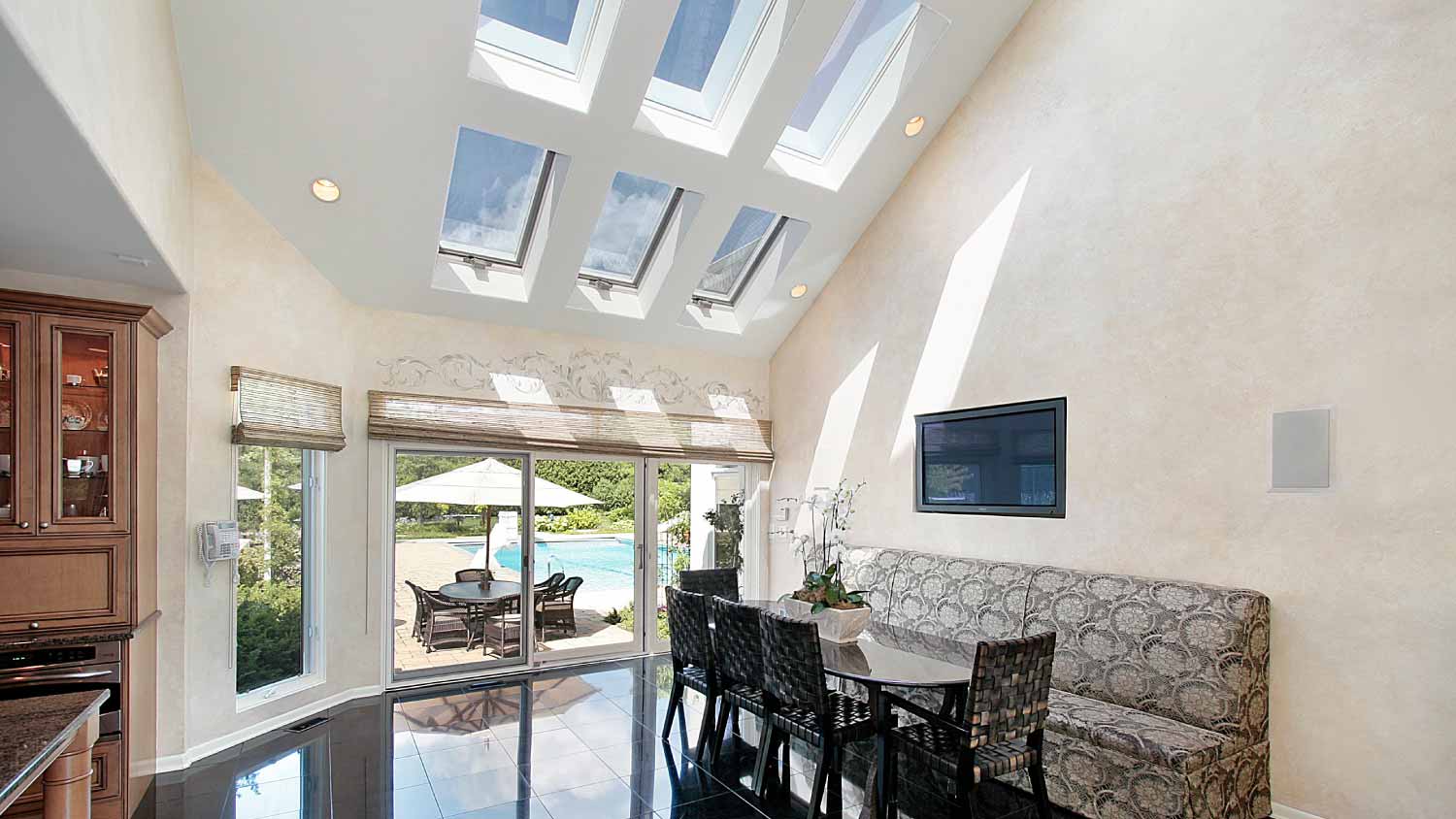
Custom skylights can be a unique shape, fit a particular space, or have special detailing. They might even feature stained glass or colored plastic. Custom skylights are often the most expensive option, but can give you the exact look you want.
| Pros | Cons |
|---|---|
| Made to fit any space | Most expensive |
| Suits your tastes perfectly | Not offered by all installers |
Best For: Homeowners looking for a unique window solution for their space.
How to Pick a Skylight
Choosing the right skylight type for your space can be a complicated decision. You’ll need to consider the shaft style, how it’s mounted, whether it’s solar-powered, whether you want ventilation, how much natural light you want to bring indoors, and more. You can use the tips below or work with a local interior designer or skylight contractor to ensure your skylight meets your functional and aesthetic desires.
1. Select the Skylight Type You Want
Look at various types of skylights, from vented rectangles to pyramids, to determine what will look best in your space. Consider the cost, style of the room, and how much light you’d like to have. You can also consider what type of skylight shaft you want, the mounting options, and the mode of operation that would be the most convenient for you.
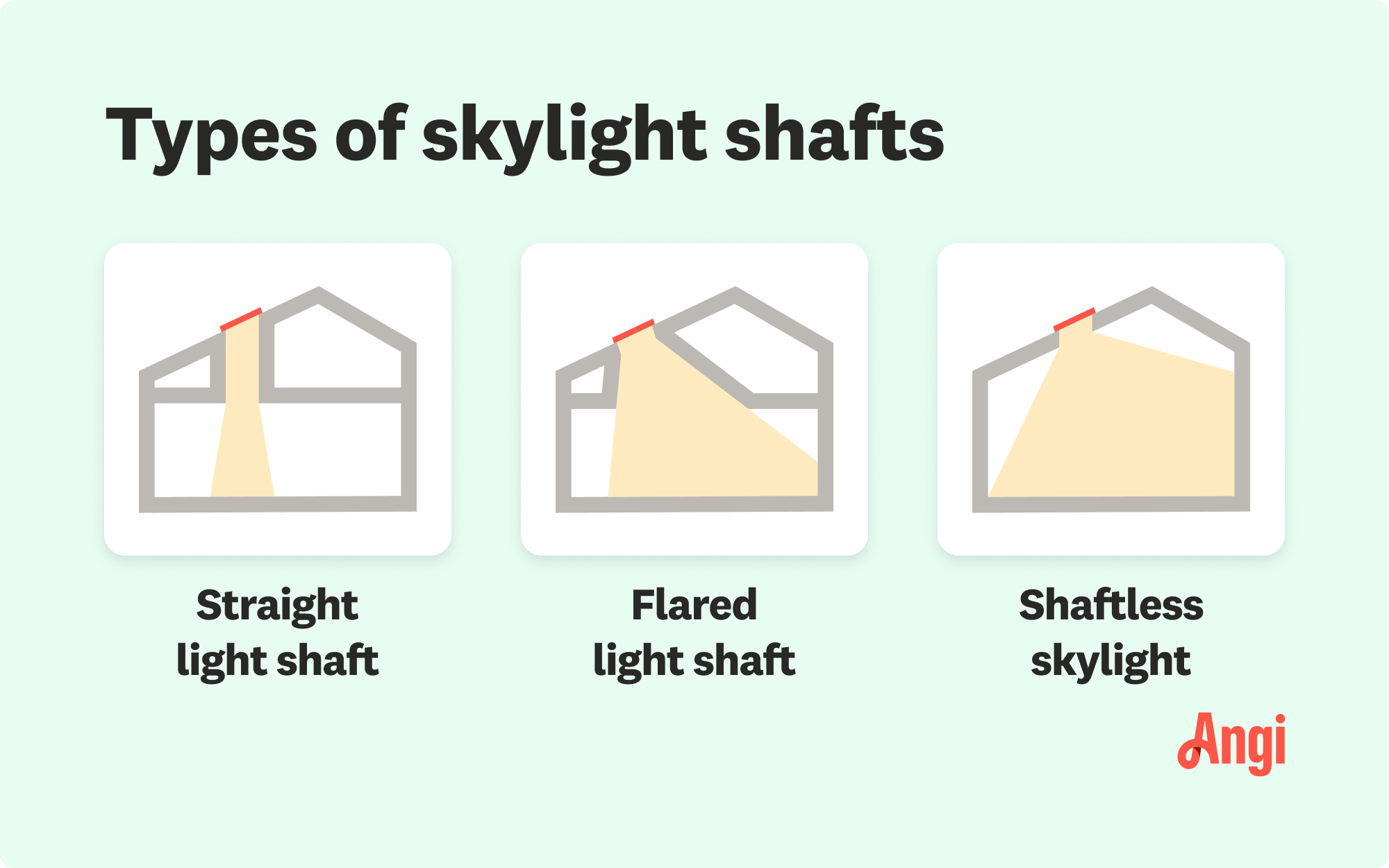
2. Calculate the Size
The U.S. Department of Energy recommends that the skylight not be larger than 5% of the total floor area in a space with three or more windows. In a space with fewer than three windows, you can go as large as 15% of the floor area with the size of your skylight without compromising your energy efficiency too much. If you’re replacing a skylight with a new one, you don’t need to worry much about the size if you just buy one that fits in the opening.
3. Determine the Position and Location
Ensure that your skylight will illuminate the area at the right hours of the day based on the sun’s location over your home and the direction of your skylight. You don’t want overexposure to UV rays, either, so you might need to invest in skylight shades, as well.
Work with an interior architect or skylight contractor to help you determine the best placement. The size and shape of the room and how it meets with the roof can also play into where and how you place your skylight.
4. Choose Your Glazing and Material
The panes and glazing of your skylight can help block UV rays, absorb heat, and prevent your furniture and carpet from fading from exposure to sunlight. You can choose double-pane glass for good energy efficiency and sound insulation or more expensive triple-pane glass for even better performance. You can also invest in window tinting or low-emissivity (low-E) coatings to boost the efficiency of your skylight.
Most skylight panes are made from either glass or plastic. Glass is the longer-lasting option, as it is more durable. Plastic is the more budget-friendly option, but ensure you get one with a coating to prevent it from yellowing.
5. Look at Costs
Skylight installation costs anywhere from $500 to $5,000, depending on the type and size of the skylight. A smaller fixed skylight falls on the lower end, while a customized or larger skylight falls on the higher end.
DIY vs. Hiring a Pro
Even if you have some experience with window installation, we recommend you leave skylight installation to the professionals.
Installing a standard window yourself is risky and challenging, but maneuvering a heavy skylight onto the roof is dangerous, especially if you’re working on a sloped roof. Additionally, skylights are the most likely windows to leak if installed improperly, so any mistakes you make during the installation are more likely to lead to the skylight leaking, water damage, and mold growth inside your home. If you don’t seal the skylight properly, cold and hot air could get in or out, driving up your energy costs—the exact opposite of what a skylight should be doing.
For most homeowners, skylight installation is better left in the hands of experienced pros. Hire a local skylight installation specialist to ensure your skylight withstands all weather conditions and lasts for years to come.
Frequently Asked Questions
Leaks are the top concern for skylights, often due to improper installation or worn-out seals. Over time, water can seep in and cause major damage to your home’s ceilings and walls. Other common issues include condensation, which leads to mold, as well as physical damage from weather or debris. If they’re not sealed properly, skylights can also bring unwanted heat in the summer or cold in the winter, affecting your home’s energy efficiency and tacking on extra dollars to your bills.
A skylight typically lasts between 15 and 20 years, though some may need replacing sooner—around eight to 15 years—depending on several factors. Durable materials, like laminated or tempered glass, can help it last longer, while poor installation or harsh weather can shorten its lifespan. Regular maintenance, such as cleaning and checking seals, will go a long way in extending its life. If you’re in an area with extreme weather, expect some wear and tear sooner, but a well-maintained skylight should serve you well for years.
Yes, you can replace a skylight without changing the entire roof—if the roof is in good shape. First, you need to make sure the roof around the skylight is intact and free of damage. Quality installation is crucial to prevent leaks, including replacing the flashing, which seals the skylight to the roof. While replacing the skylight alone is doable, it can make sense to replace both at once to streamline the work, coordinate the warranties, and reduce the risk of future leaks. If you’re unsure, reach out to a professional for help in deciding the best approach.





- What Is a Skylight? Explore Different Types, Common Problems, Costs, and More
- What to Know About Skylight Replacement
- Your Guide to Skylight Installers: Who Installs Skylights?
- Roof Window vs. Skylight: Choosing the Right Option for Your Space
- Solar Tube vs. Skylight: Which One Should You Choose?
- Who Do I Call To Repair a Skylight?
- Do You Need Solar Tube Repair or Replacement? Expert Advice to Help You Decide
- 4 Reasons Your Skylight Is Leaking and How to Repair It
- 15 Types of Windows and How to Choose the Right Ones
- 25 Attic Ideas to Create a Cozy, Functional Getaway










